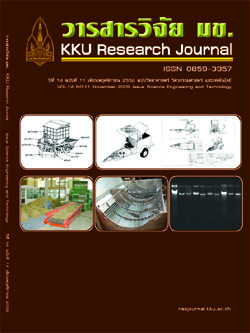Efficiency of Trichoderma spp. for induction of foliar disease resistance in tomato (Thai)
Main Article Content
Abstract
The efficiency of 4 isolates of Trichoderma spp. isolated from cultivated soil of the northeastern region, T9 (T. harzianum), T13 (T. asperellum), T17 (T. asperellum) and T18 (T. asperellum) on the folia disease resistance induction in tomato was studied. The fungi was cultivated on sterilized sorghum grains and mixed in soil (2 % w/w). Tomato plants were transplanted into pots for two weeks, and then inoculated with folia disease pathogens, Xanthomonas campestris pv. vesicatoria (XCV), Stemphylium solani and Corynespora cassiicola. The number of leaf spot symptoms for each pathogen was evaluated. The results show that isolate T9 (T. harzianum) reduced bacterial spot numbers the most at 69.32 %. The T13, T17 and T18 expressed spot reduction in descending order. For Stemphylium leaf spot, the isolate T18 reduced leaf spot of 19.23 % more than isolate T9. However, T13 and T17 did not reduce spot numbers (P>0.01). The isolate T18 exhibited target spot reduction of 11.00 %. Isolates T9 and T13 followed and T17 was not able to induce target spot resistance in tomato. This present study suggests the induction of folia diseases of tomato by using the antagonistic fungus, Trichoderma spp.
Article Details
References
Engelberth, J., E.A. Schmelz, H.T. Alborn, Y.J.Cardoza, J. Huang, and J.H. Tumlinson.2003. Simultaneous quantification ofjasmonic acid and salicylic acid in plantsby vapor-phase extraction and gaschromatography-chemical ionization-massspectrometry. Anal. Biochem. 312: 242-250.
Harman G.E., C.R. Howell, A. Viterbo, I. Chet, andM. Lorito. 2004. Trichoderma speciesopportunistic, avirulent plant symbions.Microbiology 2: 43-56.
Hurtado, O. 2004. Study and manipulation of thesalicylic acid-dependent defense pathwayin plants parasitized by Orobancheaegyptiaca Pers. Master of Sciences Thesis,Plant Physiology, Virginia PolytechnicInstitute and State University, USA.
Jones, D.A. and D. Takemoto. 2004. Plant innateimmunity-direct and indirect recognition ofgeneral and specific pathogen-associatedmolecules. Curr. Opin. Inmu. 16:48-62.
Koch, T., T. Krumm, V. Jung, J. Engellbelbrth andW. Boland. 1999. Differential induction ofplant volatile biosynthesis in the lima beanby early and late intermediates of theoctadecanoid-signalling path way. PlantPhysiol. 107:153-162.
Parker, E.J. 2000. Signalling in plant diseaseresistance. Pp. 198-217 in: Dickinson M.and Beynon J. (ed). Molecular plantpathology. Sheffield Academic Press,Sheffield, U.K.
Saksirirat, W. and H.H. Hoppe. 1991. Secretion ofextracellular enzyme by Verticilliumpsalliotae Treschow and Verticillium lecanii(Zimm,) Viegas during growth onuredospore of the soybean rust fungus(Phakopsora pachryrhizi Syd). Inliquidcultures. J. Phytopathol. 131: 161-173.
Saksirirat, W., M. Chuebandit, P. Sirithorn, and N.Sanoamuang. 2005. Species diversity ofantagonistic fungus, Trichoderma spp.From seed production fields and itspotential for control Fusarium wilt oftomato and cucurbits. The 4th InternationalConference on Biopesticides. Feb.13-18,2005. Imperial Maeping Hotel, Chiangmai,Thailand.
Van Loon, L.C. and E.A. Van Strien, 1999. Thefamilies of pathogenesis-related proteins,their activities, and comparative analysisof PR-1 type proteins. Physiol. Molec. Pl.Pathol. 55: 85-97.
Wasternack C., I. Stenzel, B. Hause, G. Hause, C.Kutter, H. Maucher, J. Neumerkel, I.Feussner, and O. Miersch. 2006. The woundresponse in tomato - Role of jasmonic acid.J. Pl. Physiol. 163: 297-306.
Yedidia, I., N. Benhamou, Y. Kapulnik, and I. Chet.2000. Induction and accumulation of PRproteins activity during early stage of rootcolonization by the mycoparasiteTrichoderma harzianum strain T-203. PlantPhysiol. Biochem. 38: 863-873.


